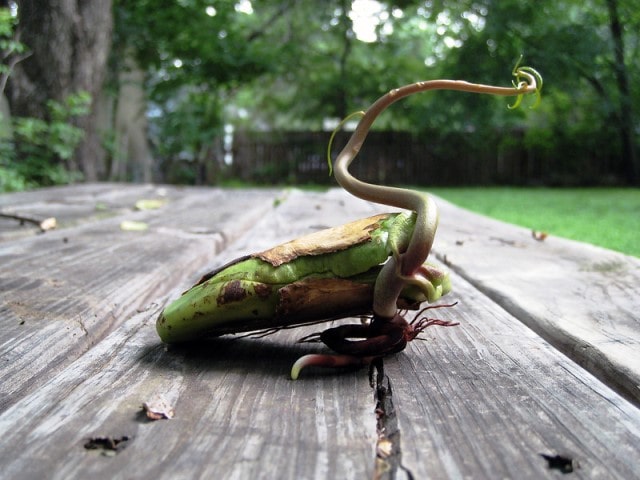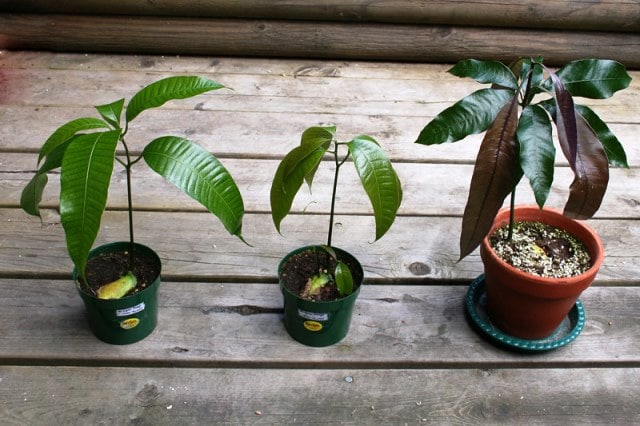Mango is a delicious fruit and has a wonderful flavor. It is the king of fruit, loaded with vitamins A and C and other beneficial nutrients for your body.
Mango trees require less care and maintenance compared to any other fruit-bearing tree. So you can easily grow them in your garden. But the flavor of the fruit will vary depending upon the seed you choose for planting. So, we suggest tasting the mangoes first and then planting the seeds.
Mango trees are tropical plants, they require a temperature ranging from 24 to 27 degrees. Few varieties of mango can be grown at a much lower temperature. Common mango varieties that you will find in the supermarkets of North America are Honey, Francis, Haden, Keitt, Kent, Tommy Atkins, Alphonse, Edward, Kesar, and Manila.
Mango trees usually grow 30-65 tall and survive over 100 years. So, if you love mangoes, grow them in your yard and pluck fresh ripe delicious mangoes every summer.
The article discusses step-by-step methods on how to grow mango trees from store-bought. So, keep scrolling through this article to learn more about the propagation methods of mangoes so that you can cultivate them in your yard.
When you buy mangoes from stores, make sure your mango is not seedless Sindhu variety. A new mango plant can not be grown if the fruit does not have a seed.
MORE POSTS: How to grow kiwi from store bought fruit?
How To Grow Mango Tree From Store-Bought Fruit?

Mangoes take many years to mature and produce fruits. But, you must plant these trees in tropical or subtropical climates with high humidity.
You can easily grow a mango tree from store-bought mangoes. We are discussing below how to grow mango trees from store-bought.
1. Buy A Ripe Mango
Your first duty is to buy ripe mangoes from the grocery store. Every mango you purchase will have a seed inside it and is protected by a husk-like covering.
Always choose ripe mango for plantation; otherwise, the seed within the husk may not be mature enough to germinate.
2. Remove Husk From The Mango
Cut the mango flesh to find the husk inside it. Your next duty is to scrape off all the pulp from the husk with a knife. You can even hold the husk under water and use a soft brush to remove the pulp. This process will help the husk to dry fast and open easily.
The seed will be there inside the husk. Healthy mango seeds will look fresh and suitable for planting. Some mango seeds can wither and dry when exposed to low temperatures. Remember, such seeds are not ideal for planting.
3. Remove The Seed From The Husk
Now your next duty will be to cut the husk edges with scissors. You will find a seed inside it.
You must wear gloves while handling the mango seed. The seeds produce sap which can irritate your hands.
4. Prepare the Mango Seeds
There are mainly two methods of preparing mango seeds. The first is the soaking method, and the second is the drying method.
In soaking, you must soak the mango seed in water for almost 2-3 weeks. It makes the germination of mango seeds faster but can increase mold.
Now let’s discuss the drying method. Place the mango seed in a paper towel and keep it in a dry airy place for almost three weeks. You can crack open the seed and allow it to dry thoroughly for the next week.
Alternative Method
- Take a cloth and dampen it in warm water to become moist. But don’t wet too much that water will drip from the cloth.
- Now wrap the mango seed in a damp cotton cloth and put it in a plastic bag.
- If you have many mango seeds, wrap the cotton cloth separately and put them in a different plastic bag to avoid the roots from becoming entangled.
- Place the plastic bag in a warm sunny region and allow it to germinate.
- You need to check the seed within three to four days.
- You can click photos and keep them on your mobile if you find any changes in the seed.
- You can dampen the paper towel if required.
- Sometimes the seed will divide during germination. It happens mainly when the components inside the seed start swelling up.
- You may visualize red sprouting from the seeds. Well, you don’t need to get worried about it. The red sprout will change its color to green when exposed to sunlight. It mainly happens when you wrap the seed with the help of a paper towel and keep it in a dark place like a kitchen cupboard.
5. Put Fertile Soil In A Container
Take a container and fill it with potting soil and compost. Ensure the pot has drainage holes to drain out all the excess water. You need to make a small hole in the soil and insert the mango seed inside it.
You can place the mango seed directly in the ground. But placing the mango seed in a pot will control the temperature in the early planting stage.
Always place the pot where the seedling can be exposed to sunlight for 8-10 hours.
6. Water The Seed
You have to water the seed thoroughly to germinate within a few weeks. You will observe seedlings within 3-5 weeks, depending on the variety of mango.
7. Allow The Seedling To Grow
Now allow the seedling to grow until it develops a healthy root system. Some mango plants can grow indoors for almost one to two years, and you can then transplant them to your yard.
8. Transplant Mango Plant
You can allow the mango tree to grow indoors, but it will not bear fruit. The mango tree will grow with time, and you need to transplant it to the ground to extend its roots and grow properly.
Your next duty is to choose where the mango plant will receive a good amount of sunlight. Additionally, the soil should be fertile and drain out excess water easily.
Another thing you need to remember is that the area where you will be growing mango trees will not interfere with the buildings and plumbing.
9. Leave Your Mango Plant In a Container
If you stay in the cool winter season, leave the mango plant in the container and transfer it to the ground when the frost disappears.
10. Plant The Seedling
You have to dig a big hole in your yard. The hole must be three times larger than the size of the root ball. You have to place the mango seedling which you have developed in the pot carefully on the hole.
The seedling can break during transplantation. So you need to be very gentle during the process.
11. Give Fertilizer And Water
You need to water your mango plant thoroughly from time to time. You even have to give fertilizer within a gap of a few months. But don’t overfertilize, as it can cause adverse effects on the growth of the mango plant.
The care of the mango plant can be pretty challenging if you don’t know how much water needs to be provided to the plant.
There are even other factors that you have to consider for proper growth. For instance, fruitflies and other pests can attack mango trees. So regularly watering your plant can keep the pests away from the tree.
The mango tree you have grown in the ground doesn’t need to be watered regularly. But if you have grown a mango tree in a pot, you must give water almost regularly.
How to preserve mango seeds for planting?
The mango seed is a dicot seed with two fleshy cotyledons that store food for the plant.
To preserve mango seeds for later planting, do not remove the outer cover of the seed. If you remove the outer hardcover, the seed may get damaged or may get sprouted on its own.
There are various methods of preserving mango seeds. But the most effective method of preserving mango seeds is by freezing them. It is because freezing does not allow bacteria and fungi to grow.
Place the mango seed in a plastic zip-lock bag and add silica gel packets. Freeze the mango seeds until you prepare the soil to plant them.
Mango Planting Methods

There are various methods of propagating the mango plant. We are discussing some of them below.
1. Grafting
Grafting is a technique in which you need to join two plants so that they will grow together. This technique will help bear fruits and flowers earlier than other mango plant propagation methods. Try to do grafting mainly in the summer season and early morning for the best possible results.
You need to have a few essential tools for grafting. We are listing them below.
- Pruning scissor
- Grafting knife
- Grafting tape
- Newspaper
- Plastic bag
Now let us discuss the grafting methods step by step below.
1. Select Rootstock Tree
Choose the rootstock from a mango tree that has grown from the seed. But remember, the mango tree should be at least six months old and 3-4 mm thick.
The plant should also be healthy and free from any diseases.
2. Choose scion
Now your next duty is to choose a scion. You have to select a scion from a high-yielding plant. Simultaneously it must be free from any diseases.
Try always to take scion from a young branch. Its thickness should match the thickness of the rootstock. It must have either one or two swollen buds that have not opened.
Now cut the scion with a knife. You can then wrap the scion in a wet newspaper and seal it in a plastic bag. You can keep it in the bag until you can graft the mango plant. But we will recommend you graft immediately after cutting the scion.
3. Prepare rootstock
You have to cut the rootstock at 8cm above soil level. Ensure that the rootstock and scion should have the same thickness level. Split rootstock to an approximate depth of 1 inch for grafting.
4. Prepare Scion For Grafting
Now cut the scion on both ends, especially the lower ends, to give V shape.
5. Join Both Rootstock and Scion
Your next duty is to insert the scion inside the rootstock slit. Remember that the thickness of the rootstock should be almost the same as the scion. If it’s not there, then you have to reshape the scion.
6. Seal The Graft
You have to seal the graft with a polythene strip. Cover the scion entirely to raise both temperature and humidity.
You will observe new leaves emerging from it within 2-4 weeks. Remove the seal when the wound is healed completely.
2. Through Seed
You must follow the steps below if you plant a mango tree by its seeds.
- Cut the slices of mango.
- You will find a seed husk inside it.
- Take scissors or kitchen shears and remove the seed from inside the husk.
- The mango seed is usually slippery. So you have to handle it carefully.
- Some seeds have a papery coating. You need to remove this before proceeding to the next step.
- Soak mango seed in water for almost 24 hours.
- You have to then wrap the mango seed with the help of a paper towel.
- Place the wrapped mango seed inside a plastic bag.
- Keep it in a dark warm place.
- Monitor the seed almost every three to four days.
- The seed will germinate within three to four weeks.
- You can plant the mango seed directly on the ground or in a pot.
How to open a mango seed?
You can open the mango seed using a knife or a spoon. Make sure you do not damage the embryo of the seed. If you damage the embryo, the seed may get damaged.
Find the seam between two halves of the husk, and insert a knife or spoon to crack open the seed. After we crack open the mango seed, we can plant the inside embryo to get a new mango plant.
You can also get new saplings by keeping the seed in a wet paper towel or directly in water.
You can open the mango seed in the following ways.
- You will find mango husk after removing all the pulp from the mangoes.
- Clean the seed husk thoroughly.
- Now your next duty is to cut the edges of the husk with the help of scissors or kitchen shears.
- The seeds will have a slippery coating. So you must proceed gently after it.
Conclusion
Mango seeds usually germinate within three weeks. You need to transplant the roots to a sunny spot in your yard once it develops a good root system. It usually takes 7-8 years to bloom flowers and bear fruits.
You can also adopt another propagation method, i.e., the grafting method. In such a case, you have to insert the scion inside the rootstock split. This process will produce fruits faster compared to seed propagation.
Additionally, remember to apply fertilizer from time to time. You need to also give water frequently for the proper growth of the plant.
MORE POSTS: How to grow kiwi from store bought fruit?
